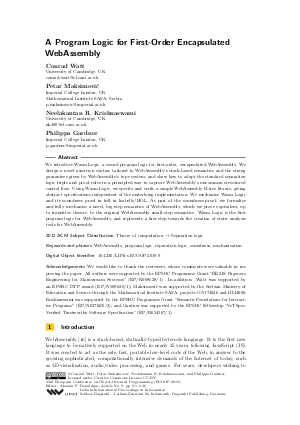@InProceedings{watt_et_al:LIPIcs.ECOOP.2019.9,
author = {Watt, Conrad and Maksimovi\'{c}, Petar and Krishnaswami, Neelakantan R. and Gardner, Philippa},
title = {{A Program Logic for First-Order Encapsulated WebAssembly}},
booktitle = {33rd European Conference on Object-Oriented Programming (ECOOP 2019)},
pages = {9:1--9:30},
series = {Leibniz International Proceedings in Informatics (LIPIcs)},
ISBN = {978-3-95977-111-5},
ISSN = {1868-8969},
year = {2019},
volume = {134},
editor = {Donaldson, Alastair F.},
publisher = {Schloss Dagstuhl -- Leibniz-Zentrum f{\"u}r Informatik},
address = {Dagstuhl, Germany},
URL = {https://drops.dagstuhl.de/entities/document/10.4230/LIPIcs.ECOOP.2019.9},
URN = {urn:nbn:de:0030-drops-108011},
doi = {10.4230/LIPIcs.ECOOP.2019.9},
annote = {Keywords: WebAssembly, program logic, separation logic, soundness, mechanisation}
}

 Creative Commons Attribution 3.0 Unported license
Creative Commons Attribution 3.0 Unported license









